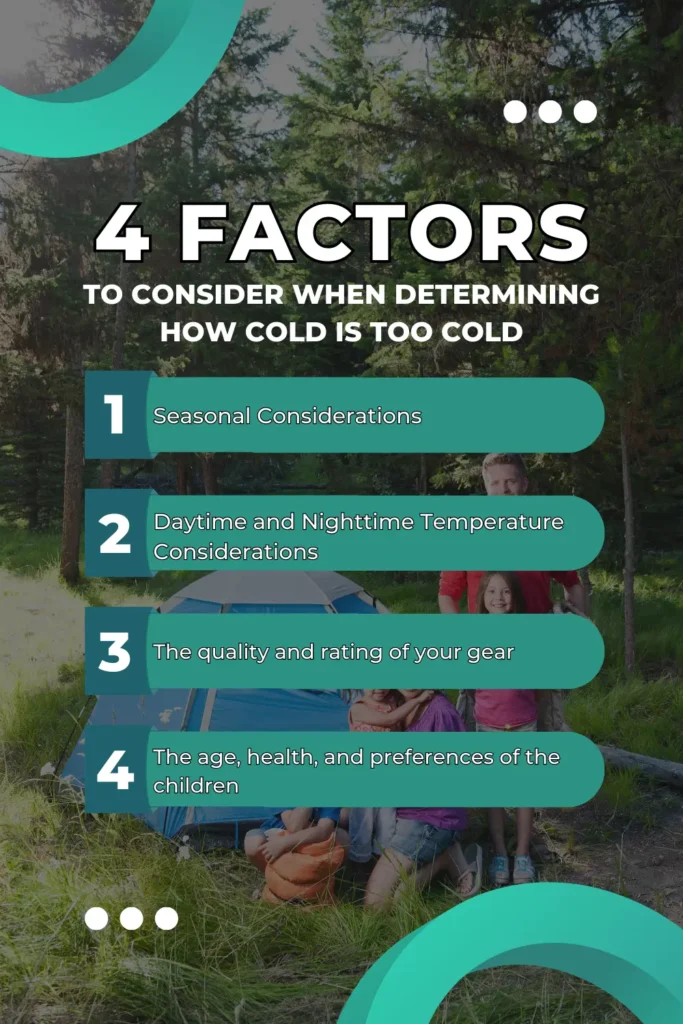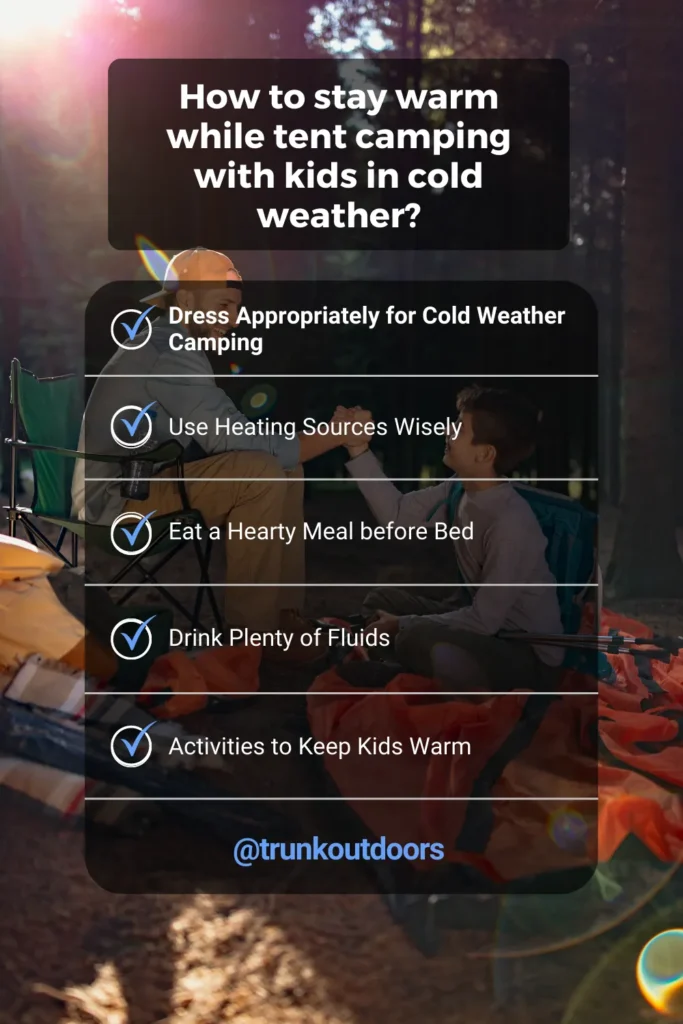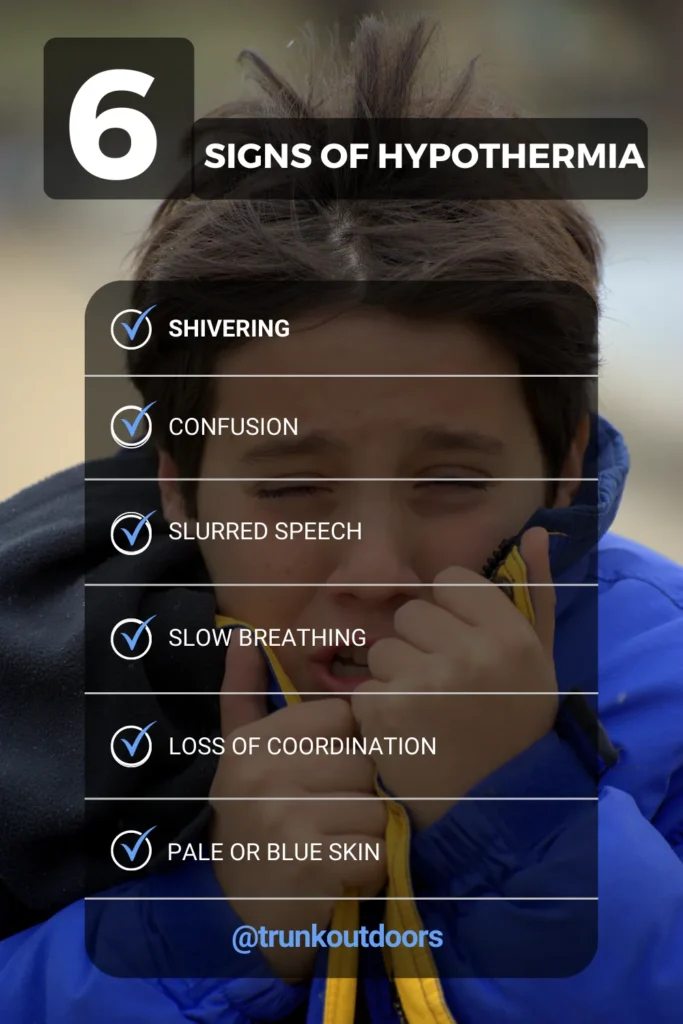How Cold is Too Cold to Tent Camp with Kids?
Planning a camping trip with your kids can be an exciting adventure, but it’s important to consider the weather conditions before embarking on your outdoor journey. One of the key factors to keep in mind is the temperature.
As a responsible parent, you may be wondering, “How cold is too cold to tent camp with kids?” In this article, we will explore the optimal temperature range for camping with children and provide you with useful insights and tips to ensure a safe and enjoyable camping experience.
How Cold Is Too Cold for tent Camp With Toddlers?
When it comes to camping with kids, their safety and comfort should always be the top priorities. While there is no definitive answer to this question, certain factors can help you make an informed decision. Some of these factors include:
- Seasonal Considerations
- Daytime and Nighttime Temperature Considerations
- The quality and rating of your gear (tent, sleeping bags, and sleeping pads)
- The age, health, and preferences of the children
But, As a general guideline, it’s recommended to avoid camping when the temperature drops below 30 degrees Fahrenheit.
Factors to Consider When Determining How Cold is Too Cold

1. Seasonal Considerations
When planning a cold weather camping trip with kids, it’s important to assess the suitability of different seasons. Each season brings its advantages and challenges.
For example:
- Spring offers milder temperatures, but the unpredictability of weather can pose challenges.
- Summer provides warmer days, but it can be crowded in popular camping destinations.
- Fall offers beautiful foliage, but temperatures can drop rapidly.
- Winter brings serene landscapes but requires meticulous planning for safety and comfort.
2. Daytime and Nighttime Temperature Considerations
Here are some practical temperature guidelines for both daytime and nighttime camping with children.
Daytime
During the day, it’s important to choose a temperature range that allows for enjoyable outdoor activities and excursions without the risk of overheating or discomfort.
The optimal daytime temperature for tent camping with kids generally falls between 60°F (15°C) and 80°F (27°C).
At temperatures below 60°F (15°C), it may become challenging for children to engage in outdoor activities without proper thermal protection.
Ensure that kids are dressed in appropriate layers to stay warm and comfortable during cooler daytime temperatures.
Additionally, consider the wind chill factor, as it can make the air feel colder than the actual temperature.
On the other hand, temperatures exceeding 80°F (27°C) can pose risks of heat-related issues such as dehydration and heat exhaustion, especially for young children.
Make sure to provide shade, encourage frequent hydration, and plan activities that allow for breaks and rest in cooler areas.
Nighttime
As the sun sets and temperatures drop, ensuring a comfortable and safe sleep environment for children becomes crucial.
The recommended nighttime temperature threshold for tent camping with kids is generally above 50°F (10°C).
When temperatures fall below 50°F (10°C), it’s essential to provide adequate insulation and warmth to prevent discomfort and potential health risks such as hypothermia.
Ensure that children are dressed in layers appropriate for colder temperatures and have proper insulation in their sleeping gear, including sleeping bags rated for the expected nighttime temperature.
Consider factors such as wind speed and humidity, as they can significantly affect how cold it feels during the night.
It’s important to regularly monitor weather forecasts and be prepared with extra blankets or sleeping bag liners to add an additional layer of warmth if needed.
By following these temperature guidelines for both daytime and nighttime camping, you can provide a comfortable and enjoyable experience for your kids while prioritizing their safety and well-being.
Remember to always adapt these guidelines based on your location, weather conditions, and individual needs of your children.
3. The Age of the Children
One of the key factors to consider when deciding how cold is too cold to tent camp with kids is their age.
Though there is no general rule to determine if children are too young for camping, Dr. Terry doesn’t recommend taking a baby camping under 50 degrees Fahrenheit.
“Babies lose heat more quickly than older children and adults. Early symptoms of hypothermia include: shivering; cold, pale, or blue-gray skin; decreased alertness.”
Michelle Terry, MD, a pediatrician at Seattle Children’s Hospital
Therefore, it’s important to be cautious and avoid exposing young children to extremely cold temperatures.
4. The Health of the Children
Children with pre-existing health conditions, such as asthma or respiratory problems, may be more susceptible to the effects of cold weather.
It’s essential to consult with a healthcare professional before embarking on a tent camping trip in cold conditions if your child has any underlying health concerns.
5. Preferences
Some people enjoy cold weather more than others. They may have higher tolerance or adaptation to cold weather than others. They may also have different expectations or standards for comfort than others.
Therefore, you should respect your own preferences and those of your kids when deciding whether to go tent camping with kids in cold weather or not.
6. Assessing Temperature Ratings for Gear
One of the most important things to consider when tent camping with kids in cold weather is the temperature rating of your gear. This includes your tent, sleeping bags, and sleeping pads.
# Tent
The temperature rating of a tent indicates the lowest temperature at which the tent can provide adequate protection from the wind and rain. However, it does not mean that the tent will keep you warm inside. You still need a good sleeping bag and pad to insulate you from the cold ground and air.
# Sleeping bag
The temperature rating of a sleeping bag indicates the lowest temperature at which the sleeping bag can keep an average person warm.
However, this rating is not a guarantee, as different people have different comfort levels and heat production. You should also consider the type of sleeping bag you have: synthetic or down.
- Synthetic sleeping bags are cheaper, more durable, and more resistant to moisture than down sleeping bags.
- Down sleeping bags are lighter, more compressible, and more efficient at trapping heat than synthetic sleeping bags.
# Sleeping pad
The temperature rating of a sleeping pad indicates the amount of insulation the pad provides from the cold ground.
Sleeping pads are measured by their R-value, which ranges from 1 to 10. The higher the R-value, the more insulation the pad provides.
They can be made of foam, air, or a combination of both. Foam pads are cheaper, more durable, and more reliable than air pads. But air pads are lighter, more comfortable, and more adjustable than foam pads.
Generaly, you should choose a tent that can withstand the lowest expected temperature at your campsite, a sleeping bag that is rated 10°F lower than the lowest expected temperature at your campsite, and a sleeping pad that has an R-value of at least 3 for cold-weather camping.
How to stay warm while tent camping with kids in cold weather?

To ensure the comfort and safety of your kids during cold-weather tent camping, here are some valuable tips:
1. Dress Appropriately for Cold Weather Camping
Another important factor to consider when tent camping with kids in cold weather is the type and amount of clothing and accessories you wear.
You should dress yourself and your kids in layers that can be easily added or removed depending on the temperature and activity level.
You should also choose clothing that is made of materials that can keep you warm and dry. The basic layers of clothing for cold weather camping are:
- A base layer that wicks moisture away from your skin, such as wool or synthetic fabrics
- A mid layer that insulates you from the cold air, such as fleece or down jackets
- An outer layer that protects you from the wind and rain, such as waterproof or windproof jackets and pants
Don’t forget to wear warm socks, gloves, hats, scarves, and boots to cover your extremities and prevent heat loss. You can also use hand warmers, foot warmers, or heated clothing to provide extra warmth if needed.
Related Topics:
How to Dress for Winter Camping?
2. Use Heating Sources Wisely
Another factor to consider when tent camping with kids in cold weather is the availability and use of heating sources, such as campfires, stoves, or heaters.
These heating sources can provide warmth and comfort for you and your kids, but they also pose some risks and challenges.
a) Campfires
Campfires are the most traditional and natural way of heating up your campsite. They can also serve as a source of light, cooking, and entertainment.
Cons of campfires
- Campfires require a lot of wood, which may not be available or allowed in some areas.
- They also produce smoke and ashes, which can be harmful to your health and the environment.
- They can be dangerous if not controlled properly.
b) Stoves
Stoves are another common way of heating up your campsite. They can also be used for cooking and boiling water.
Cons of stoves
- Stoves require fuel, which may be expensive or scarce in some areas.
- They also produce carbon monoxide, which can be deadly if inhaled in large amounts.
- They can cause fires or burns if not handled carefully.
Read more about: The important Camp Stove Safety Tips for Safe Outdoor Cooking
c) Heaters
Heaters are another option for heating up your campsite. They can be powered by electricity, propane, or batteries.
Cons of Heaters
- Heaters require a lot of power, which may not be available or reliable in some areas.
- They also produce carbon monoxide, which can be deadly if inhaled in large amounts.
- They can cause fires or burns if not handled carefully.
3. Eat a Hearty Meal before Bed
Eating a hearty meal before bedtime can help generate body heat during the night. Provide your children with warm and nutritious food, such as soups or stews, and ensure they have a snack before getting into their sleeping bags.
4. Drink Plenty of Fluids
Staying hydrated is essential, even in cold weather. Encourage your kids to drink plenty of fluids, such as warm water, herbal tea, or hot cocoa. Hydration helps maintain body temperature and overall well-being.
5. Activities to Keep Kids Warm
Engaging children in fun activities is not only a great way to keep them entertained but also helps generate body heat.
Plan a variety of indoor and outdoor activities that encourage movement and physical exertion. For example:
- Indoor activities could include storytelling, board games, or arts and crafts.
- Outdoor activities might involve hiking, exploring nature, or playing interactive games.
Keeping children active will help them stay warm and enjoy the camping experience.
Be Aware of the Signs of Hypothermia

Knowing the signs of hypothermia is crucial for identifying and addressing any potential issues promptly. According to the Centers for Disease Control and Prevention, the following are warning signs of hypothermia:
- Adults:
- Shivering
- Confusion
- Exhaustion or feeling very tired
- Memory loss
- Slurred speech
- Fumbling hands
- Drowsiness
- Babies:
- very low energy
- bright red, cold skin
If you notice these signs in your children, it is important to take immediate action by following these steps:
- Get the person to a warm place.
- Remove any wet clothing.
- Dry the person off with a warm towel.
- Give the person warm liquids to drink.
- If the person is unconscious, call 911.
Safety Measures for Cold Weather Camping
1. Fire Safety
Safety should always be a top priority when managing fires in cold weather. If you decide to use any of heating sources (campfires, stoves, heaters), you should follow proper fire safety protocols such as:
- Set up a fire ring around your campfire to keep it under control, using medium-sized rocks.
- Never leave them unattended or near flammable materials
- Keep them away from children and pets
- Ventilate your tent well to avoid carbon monoxide poisoning
- Follow the manufacturer’s instructions and warnings
- Have a fire extinguisher or water nearby in case of emergency
- Educate children about fire safety and establish clear rules regarding their proximity to the fire.
“No one should ever leave a camp fire unattended, and children should always be watched closely around fire. Also, make sure the fire is extinguished before everyone turns in for the night,”
Michelle Terry
2. Emergency Preparedness
- Pack essential items and supplies for emergencies, including extra clothing, blankets, first aid kits, and emergency contact information.
- Create an emergency plan that outlines steps to take in case of severe weather, injury, or other unforeseen circumstances.
- Know when to seek help from park rangers or emergency services if the situation becomes challenging to manage independently.
Alternatives to Traditional Camping in Extreme Cold
In extreme cold conditions, tent camping may not be the most suitable option, especially with children.
Exploring alternatives such as cabins or heated RVs can provide a more comfortable and safer experience.
- Cabins offer shelter from the elements while still allowing families to enjoy the beauty of nature.
- Heated RVs provide warmth, insulation, and various amenities, making them a viable option for camping in extremely cold weather.
Related topics:
Conclusion
Tent camping with kids in cold weather can be a rewarding experience filled with adventure and cherished memories. However, it’s essential to prioritize safety and take precautions to ensure the well-being of your children.
By considering factors like age, health, equipment, and weather conditions, and implementing the tips provided, you can create a warm and enjoyable camping experience for your family.
Remember to choose a campsite with proper shelter, pack warm clothing and suitable sleeping bags, and always be prepared to evacuate if weather conditions become too dangerous.